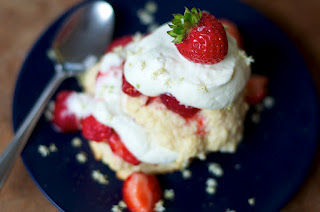YOU’LL NEED TO visit your elderberry patch in both spring and late summer to make this dessert as shown.
The Panna Cotta by itself is smooth, silky, custardy—and easy.
1 pint heavy cream
1/4 cup sugar*
1/4 oz granulated, unsweetened gelatine**
1/2 cup elderflower cordial
elderberry syrup (optional)
* I used regular granulated sugar. Ideally you would use finer baker’s sugar.
** My grocery didn’t have sheets of gelatine, so I bought a 1-oz box of four gelatine packets.
1. Heat the cream in a saucepan until not quite boiling. DO NOT BOIL.
2. Slowly whisk in sugar, making sure it dissolves thoroughly. Next, slowly whisk in the gelatine, making sure that dissolves thoroughly as well. If you’re not careful it will clump and ruin the texture of your Panna Cotta.
3. Remove from heat and stir in elderflower cordial. The flavor of elderflower is delicate and easily cooked off if subject to excessive heat. Allow to cool for a few minutes.
4. Pour into ramekins, tea cups, or moulds and refrigerate for four hours or overnight. I lightly greased my ramekins with butter. To remove Panna Cotta, dip the ramekin in a bowl of hot water for a minute or two and run the tip of a sharp knife around the edge. Shake out Panna Cotta.
5. Serve with a spoonful of elderberry syrup drizzled over the top. Contrary to most of the images of Elderflower Panna Cotta you’ll see online, served in big round quivering portions, I like to slice it into wedges. Seems more appetizing that way, to me at least. Garnish with a mint leaf or berries.












